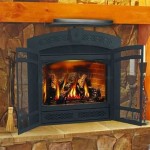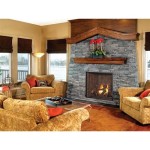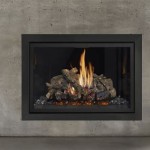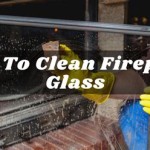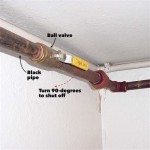Average Cost To Install A Gas Fireplace Insert
A gas fireplace insert offers a convenient and efficient way to upgrade an existing masonry or prefabricated fireplace. It replaces a traditional wood-burning fireplace with a gas-fueled appliance that provides instant heat, controlled flames, and enhanced aesthetics. Understanding the average cost associated with this upgrade is crucial for homeowners planning this type of renovation project. The total expenditure encompasses the cost of the insert itself, installation labor, materials, and potential modifications to the existing fireplace structure.
The average cost to install a gas fireplace insert typically ranges from $3,000 to $8,000. This broad range reflects various factors, including the insert's BTU rating, features, brand, and the complexity of the installation process. More elaborate models with advanced control systems, decorative enhancements, or higher heat output will naturally command a higher price. Similarly, installations involving extensive modifications to the existing fireplace, such as chimney relining or gas line extensions, will increase the overall cost. A detailed breakdown of these cost factors is essential for accurate budgeting and informed decision-making.
Factors Influencing the Cost of a Gas Fireplace Insert
Several elements contribute significantly to the overall cost of a gas fireplace insert project. These factors can be broadly categorized into the cost of the insert itself, the labor involved in the installation, and any associated materials or modifications needed to ensure proper and safe operation.
The gas fireplace insert represents the most substantial expense. Prices vary depending on the BTU (British Thermal Unit) rating, which indicates the heating capacity of the unit. Higher BTU ratings translate to greater heating output and, consequently, a higher price. The design and style of the insert also influence the price. Options range from basic, utilitarian models to more elaborate designs with realistic log sets, decorative fronts, and remote control operation. Reputable brands known for their durability, efficiency, and aesthetic appeal often command a premium price. Features such as electronic ignition, variable flame height, and built-in blowers further contribute to the overall cost.
Labor costs constitute a significant portion of the installation expense. Installation involves several tasks, including preparing the existing fireplace, running gas lines, venting the unit, and connecting the insert to the gas supply. The complexity of these tasks directly impacts the labor costs. Installations requiring extensive modifications to the existing fireplace, such as widening the opening or reinforcing the firebox, will necessitate more labor hours and specialized skills. The hourly rate charged by the installer, which can vary based on location and experience, also affects the total labor cost. It is advisable to obtain multiple quotes from qualified installers to ensure competitive pricing and to verify their credentials and insurance coverage.
Materials and modifications encompass a range of items necessary for a successful installation. These may include venting pipes, gas lines, connectors, insulation, and decorative trim. The type of venting system required depends on the insert's specifications and local building codes. Direct vent inserts, which draw combustion air from outside and vent exhaust gases directly outside, typically require specialized venting components. If the existing gas line is not adequately sized or located, a new gas line extension may be necessary. This can involve trenching, pipefitting, and connecting to the main gas supply. Modifications to the fireplace opening, such as widening or reinforcing the firebox, may also be required to accommodate the insert. These modifications can add to the overall cost, particularly if they involve structural alterations or masonry work.
Detailed Breakdown of Costs
To better understand the average cost, it's helpful to break down the expenses into specific categories and provide estimated price ranges for each.
The gas fireplace insert itself can range from $1,500 to $5,000 or more. Basic models with lower BTU ratings and fewer features typically fall at the lower end of this range. High-end models with advanced features, intricate designs, and higher BTU ratings can reach the upper end of the price spectrum. Consider factors such as heating needs, aesthetic preferences, and budget constraints when selecting the appropriate insert. Online retailers, local fireplace stores, and home improvement centers offer a wide variety of models to choose from. It is essential to compare prices and features across different brands and models to make an informed decision.
Installation labor typically ranges from $500 to $2,000, depending on the complexity of the project. Simple installations involving minimal modifications to the existing fireplace will generally fall at the lower end of this range. More complex installations requiring extensive modifications, such as chimney relining or gas line extensions, can significantly increase the labor cost. Obtain multiple quotes from qualified installers to compare pricing and ensure that the installer is licensed, insured, and experienced in gas fireplace insert installations. Inquire about their hourly rate, the estimated number of labor hours, and any potential additional charges.
Materials and modifications can range from $300 to $1,000 or more, depending on the specific requirements of the installation. Venting pipes, gas lines, connectors, insulation, and decorative trim contribute to the material costs. Chimney relining, which is often required for older chimneys, can add significantly to the expense. Gas line extensions, which involve trenching, pipefitting, and connecting to the main gas supply, can also increase the material and labor costs. Modifications to the fireplace opening, such as widening or reinforcing the firebox, may be necessary to accommodate the insert. These modifications can add to the overall cost, particularly if they involve structural alterations or masonry work.
Additional Considerations and Cost-Saving Measures
Beyond the direct costs of the insert, labor, and materials, several additional factors can influence the overall expense of a gas fireplace insert project. Awareness of these factors and proactive planning can help homeowners manage costs effectively.
Permits and inspections are generally required for gas fireplace insert installations. The cost of these permits can vary depending on local regulations and the complexity of the project. Failure to obtain the necessary permits can result in fines and delays. Inspections are typically conducted by local building inspectors to ensure that the installation complies with safety codes and regulations. These inspections can add to the overall cost, but they are essential for ensuring the safe and proper operation of the gas fireplace insert. It is advisable to consult with local building officials to determine the permit requirements and inspection procedures in the area.
Chimney condition and potential repairs can significantly impact the cost of the project. Older chimneys may require repairs or relining to ensure proper venting and prevent carbon monoxide leaks. Chimney relining involves installing a new liner inside the existing chimney flue to create a sealed and safe venting system. The cost of chimney relining can range from $1,000 to $3,000 or more, depending on the chimney's height and the type of liner used. It is essential to have the chimney inspected by a qualified professional before installing a gas fireplace insert to identify any necessary repairs or upgrades.
Energy efficiency and long-term operating costs should be considered when selecting a gas fireplace insert. Higher efficiency models may have a higher upfront cost, but they can save money on heating bills over the long term. Look for models with high AFUE (Annual Fuel Utilization Efficiency) ratings, which indicate the percentage of fuel that is converted into usable heat. Consider features such as electronic ignition, variable flame height, and built-in blowers, which can further improve energy efficiency. Compare the operating costs of different models based on their BTU rating, fuel consumption, and local gas prices. It is also worth exploring potential rebates or tax credits offered by local utilities or government agencies for installing energy-efficient appliances.

How Much Does A Gas Fireplace Insert Cost Forbes Home

How Much Does A Gas Fireplace Insert Cost To Install 2024

How Much Does A Gas Fireplace Cost Fireplaces Direct Learning Center

How Much Does It Cost To Install A Gas Fireplace Homeserve Usa

Gas Fireplace Cost Guide Unit Add Ons Installation More

Estimated Page Fireplaces Stoves Inserts Wood Gas Pellet

2024 Cost Of Gas Fireplace Insert Remodeling Calculator

2024 Gas Fireplace Insert Costs

How Much Does A Gas Fireplace Insert Cost To Install 2024

Fireplace Installation Cost 2024 Gas Wood Burning Electric
Related Posts


